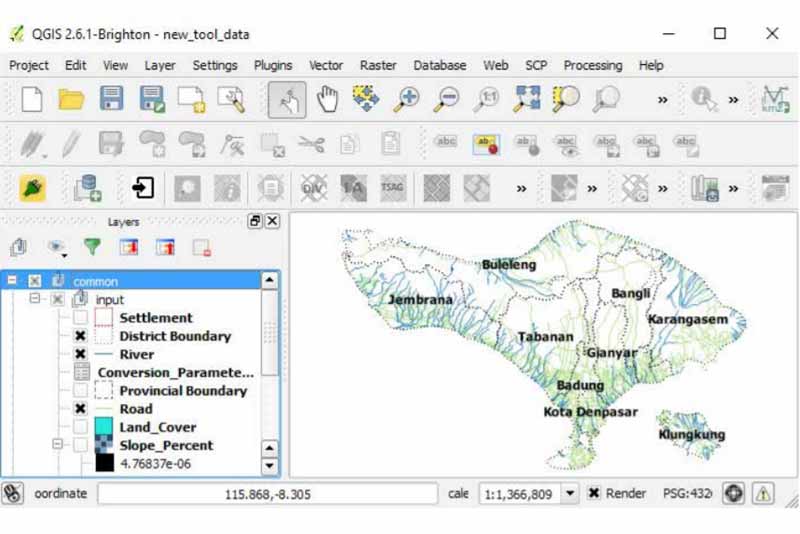
Above image: QGIS Interface with Layers/ Source: ADB
Geographic Information System (GIS)-based decision support systems (DSS) can play a significant role in arriving at the right mix of renewable energy to meet the needs of the respective localities. The Asian Development Bank (ADB) released a paper recently describing the use of such GIS-based DSS in developing a tool that quantifies the potential of five energy sources (solar, wind, biomass, hydropower, and geothermal) in a given geographical area, using Bali, Indonesia as a case study.
Free and open source GIS software, QGIS and the Geographic Resources Analysis Support System (GRASS), were used to process the data collected by a team composed mainly of staff from the Energi dan Sumber Daya Mineral (ESDM) or the Ministry of Energy and Mineral Resources of the Republic of Indonesia, World Resources Institute, and University of Tokyo.
The base topographic data included land cover, digital terrain models, road, river networks collected from the Indonesian government’s Geospatial Information Agency or Badan Informasi Geospasial (BIG). The data also covers political boundaries, i.e., province, district, and desa. A desa is the smallest administrative unit for which population and other statistical data are available. The number of households connected to the grid was obtained for each desa from the Perusahaan Listrik Negara (PLN) or State Electricity Corporation.
Data for solar, wind, hydropower and geothermal energy was provided by ESDM. For solar and wind energy, ESDM used one-degree Global Data Assimilation System (GDAS) data from the US government’s National Oceanic and Atmospheric Administration (NOAA) and National Center for Environmental Prediction (NCEP). A model developed by the Meteorological Research Institute of Japan was used for interpolation, followed by further downscaling to a 5-kilometer (km) resolution. Technical assistance was provided by the National Research Center of the Bandung Institute of Technology, Indonesia.
With input from the Department of Public Works, Indonesia, ESDM estimated the run-of-river hydropower potential. Data for the geothermal energy technical potential for Bali was extracted from ESDM’s geological agency estimation dataset generated from across the country.
For biomass energy, computerized tabular data on agricultural, plantation and forest production, and biomass residuals were integrated with desa political boundary data.
The data was grouped into four thematic groups: 1) Topography (Road, River, Contour, Digital Elevation Model, Land Cover, Spot Elevation, Settlement, Forest); 2) Administrative (Provincial, City, Municipality, Town, District, Subdistrict, Provincial capital, District capital, Town capital); 3) Demography (Population, Number of households, Number of households connected to grid; and 4) Energy (Solar, Wind, Hydropower, Geothermal, Biomass).
The total estimated technical potential from all the renewable energy sources amounts to 115,372 GWh/year with solar energy contributing to 98% of the total energy yield. This shows that even if 5% of this technical potential can be developed, the projected energy requirement of 4,993 GWh/year in Bali by 2019 can be entirely met. The paper notes that though solar power is abundant in Bali, and the price of solar panels is on a downward trend, large storage would be required if all power demand is to be met by solar energy.

Above image: L- Solar Energy Potential by Desa Boundary ; R- Technical Potential Energy (GWh/year) (GWh = gigawatt-hour)/ Source :ADB
However, without proper policy and market intervention, it would be difficult to harness this potential. The estimated quantified energy mix, along with spatial distribution at desa level can be effectively used for different sizes and types of energy generation planning, specifically for small rooftop or backyard solar or hybrid photovoltaic and mini and micro grids. A geo-enabled DSS would assist decision makers in selecting the appropriate technologies.
Once the potential has been determined, factors such as financial viability, socioeconomic impacts and technological aspects need to be brought into the decision-making process.
The work described in the paper is the first phase of a multiphase effort. The study does not assess the financial viability of the renewable energy sources. Financial feasibility of power generation depends on a variety of factors like amount of resource (this is the only aspect that is covered in this report); quality of resource; financial parameters (feed-in tariff, other incentives, interest rates, expected equity rate of return and others); economies of scale (solar photovoltaic is not as sensitive as wind to project size) and other factors like infrastructure (roads, transmission, and others). An important next step in the project would be to create a consolidated decision support model that incorporates the most important of these factors, if not all.
The GIS-based decision support system tool that was devised for this study can be used for most of the geographic areas in the region. Incorporating financial viability, socioeconomic, and technological aspects would make even more useful for policy and decision makers. Using the results of Bali as a test case, the working paper envisions presenting a tool that can be utilised for similar geographic regions.
















